The bounty of Kastoria is nothing short of spectacular! During a two-day journey through its countryside, we met people whose dedication to the land and its gifts is nothing less than inspiring. From the rich, earthy chestnuts to the crisp mountain apples and the region’s famous beans, each product tells a story of resilience and passion.
What truly stood out, however, was the surprising number of women at the forefront of this agricultural renaissance, nurturing the land and crafting its treasures with skill and pride. Everyone – both women and men – welcomed us with exceptional kindness and hospitality, sharing not only their harvests but also their stories.
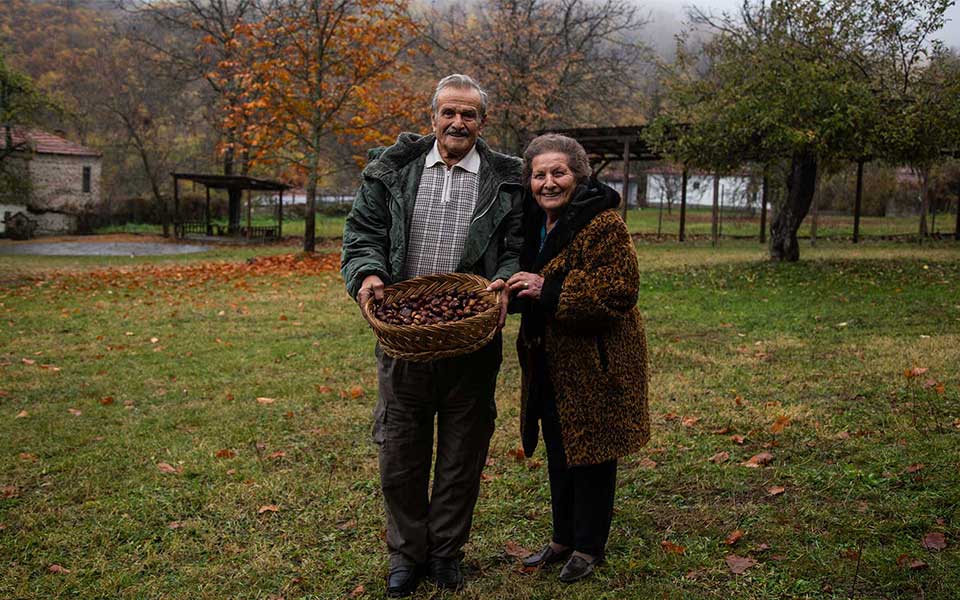
© Stelios Papardelas
Stop 1: The Chestnut Villages
As we ascend the winding roads through the forests of Mount Voio, the road signs bear names like Kastanofyto (Chestnut Grove) and Polykastano (Many Chestnuts), leaving no room for doubt – we are entering the heart of Kastoria’s famed Chestnut Villages. The landscape unfolds before us in a mesmerizing display of autumn hues, with the mountain’s deciduous trees cloaked in gold, crimson, and amber.
Through a misty veil of frozen fog, Kastanofyto gradually emerges – a village of sturdy stone houses, their weathered facades standing resolutely against the winter cold. Silent for now, the houses wait out the season, yet warmth and hospitality greet us at the community office. There, Angelos Kartzos, the village president, welcomes us with open arms, surrounded by a handful of friendly locals. Inside, the crackling wood stove fills the room with comforting heat, while the sweet scent of hot coffee, apples, and homemade treats lingers in the air – generous offerings for travelers like us.
But here, the undisputed star is the chestnut. “Our chestnuts grow wild and free, and that’s why they taste so good,” the president proudly tells us.“We don’t cultivate them; we simply gather them when they fall naturally from the trees. From October 10th to early November, the forest is alive with people, bent over, picking chestnuts one by one.”
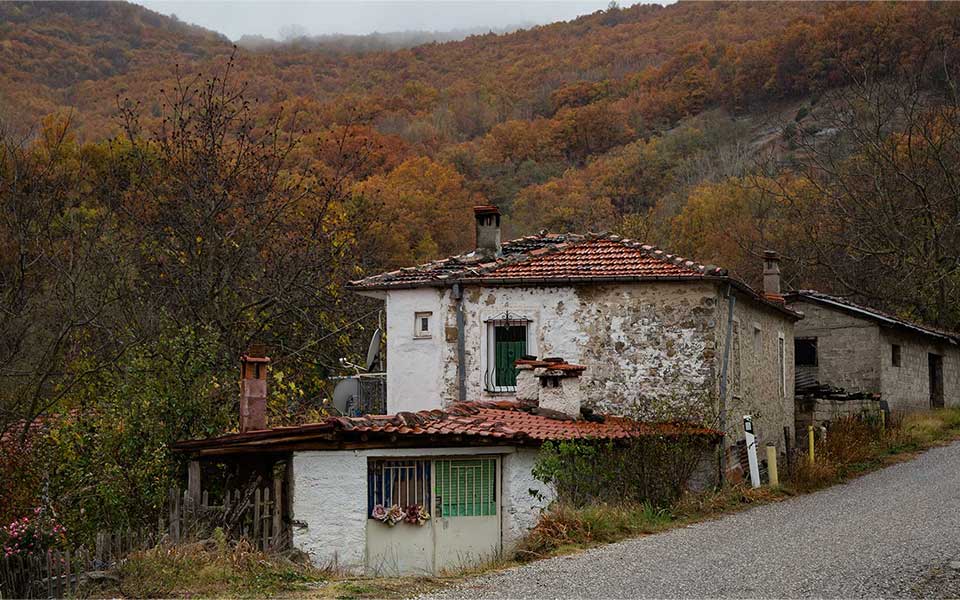
© Stelios Papardelas
The chestnut trees – some wild, others grafted, young and ancient alike – offer a variety of flavors and uses. Some chestnuts are perfect for boiling, others for roasting; some are sweet and delicate, while a few venerable trees no longer bear fruit, standing instead as towering sentinels with trunks so wide you could fit entire rooms in them. The villagers even give their trees names – Bela Eza, Blaga (meaning ‘sweet’), and many more, each with its own story. “In the old days, we picked chestnuts with bare hands, no gloves,” they recall. “By evening, our fingers would burn from the endless pricks. And it’s not just us who gather them – bears, foxes, wild boars, even thieves take their share.”
Generations ago, they devised clever ways to preserve the chestnuts through the long winter months, digging into the earthen floors of their cellars, layering ferns, spreading the spiky chestnuts, and covering them with more ferns and soil. The boiling process involved a gioumi, a tin jug-like vessel placed over an open fire. Roasting, however, is an art in itself: a strong beechwood fire is lit, encircled by a low wall of cinder blocks. A large perforated roasting tray is placed on top, and the chestnuts are continuously stirred with a rake for about five minutes – just enough to blister the shells and cook the flesh inside to perfection. The roasted chestnuts are then placed in a basket, covered with a cloth, shaken vigorously, and voilà – hot, fragrant, and ready to enjoy.
This is precisely how the welcoming villagers of Kastanofyto prepared them for us in the courtyard of the old primary school. With a few glasses of rich, local red wine in hand, we share laughter and stories, the warmth of the fire and the chestnuts filling our souls as the relentless rain continues to pour down.
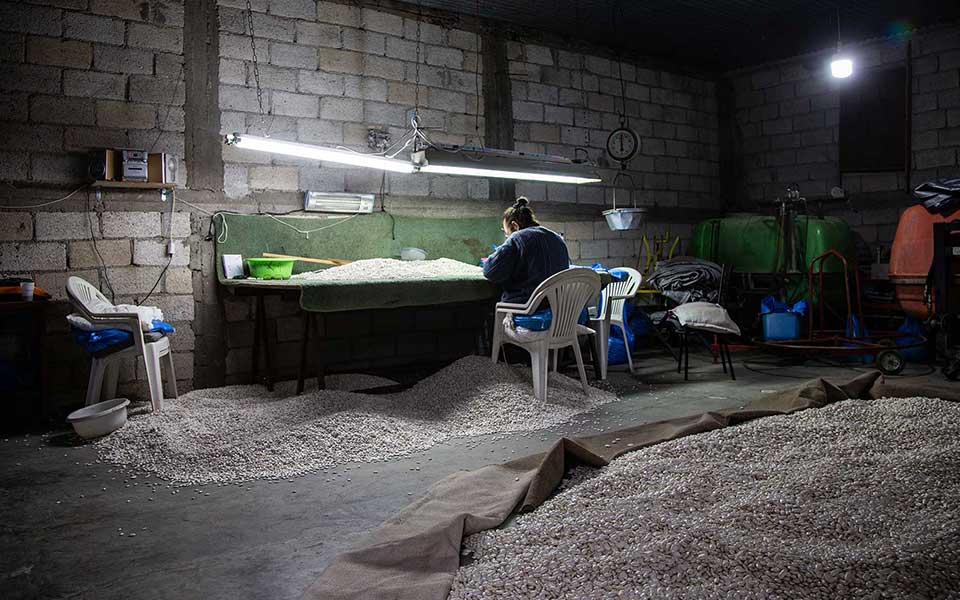
© Stelios Papardelas
Stop 2: Korestia & Lakkomata
Descending from the mountains, we reach the region of Korestia, known for producing the renowned Kastoria Giant Beans, also known as Elephant Beans, which hold a Protected Geographical Indication (PGI) status. As early winter sets in, the harvest is nearing its end, yet the bean plants still cling to their reed trellises in some fields. In the cellars of nearby homes, women are hunched over large tables under the warm glow of lamps, meticulously sorting the beans – flat ones for soups and the prized giant beans for baking. Each bean is examined carefully; the imperfect ones are discarded, and only the best make it to the market.
The initial sorting by size and color is done mechanically, but the final selection is an art – requiring the trained hands and discerning eyes of seasoned locals. Local farmer Sotiris Graiskos and his wife, Irini Sapardani, a young farming couple from Akritas in Florina, cultivate both types of beans on Sotiris’ ancestral land and sell their produce throughout Greece.
Korestia is famous for its exceptional beans, widely considered the finest in the region.
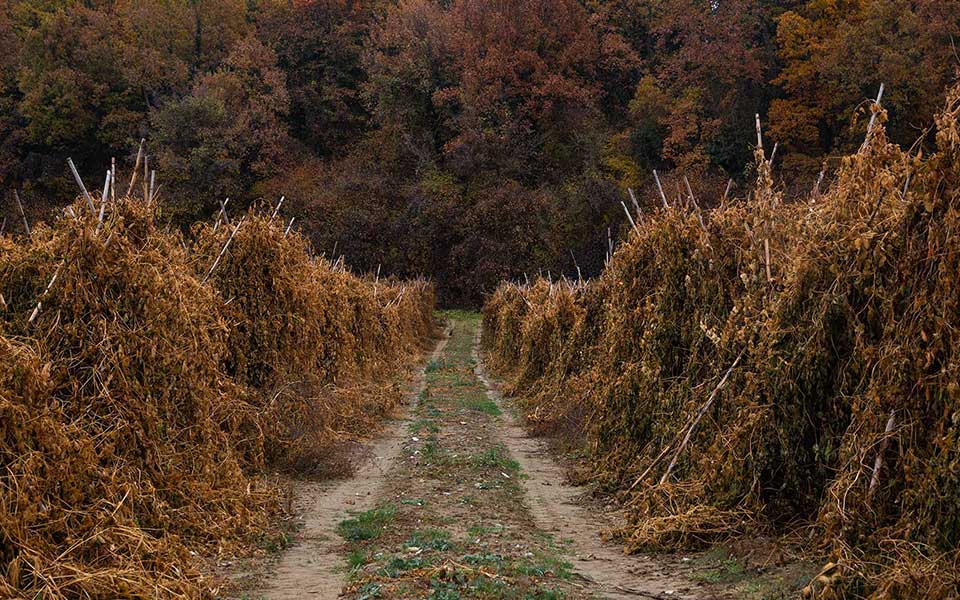
© Stelios Papardelas
Its secret? The rich, well-drained black soil, crystal-clear water from the icy springs of the Aliakmonas River, an altitude of over 800 meters, and heirloom seeds passed down through generations for nearly a century. The result is a thin-skinned, easy-to-cook bean with an extraordinary flavor. In Korestia alone, 300 farmers cultivate over 2,000 stremmata (approximately 2 million square meters) of riverside fields dedicated to bean farming.
The farmers take immense pride in their produce, yet they share growing concerns – climate change has led to fluctuating yields, and some large traders have been known to mix their beans with lower-quality imports. “Always buy beans directly from the producer,” they urge, stressing the importance of supporting local farmers and ensuring both quality and fair compensation for their hard work.
A short distance away in Lakkomata, farmer Zoe Laikou takes a safer approach, supplying her entire harvest to the well-known company Agrino. However, this year’s yield has been disappointing – barely 500 kilograms of giant beans from her 2.5 stremmata (2,500 square meters). “The beans developed late this year, which delayed the harvest. Then the cold set in, freezing them inside their pods. They shriveled and stuck together during threshing,” she explains. “It’s been a tough season. Each stremma costs around €850 to cultivate, so you need at least 200 kilograms per stremma to break even.”
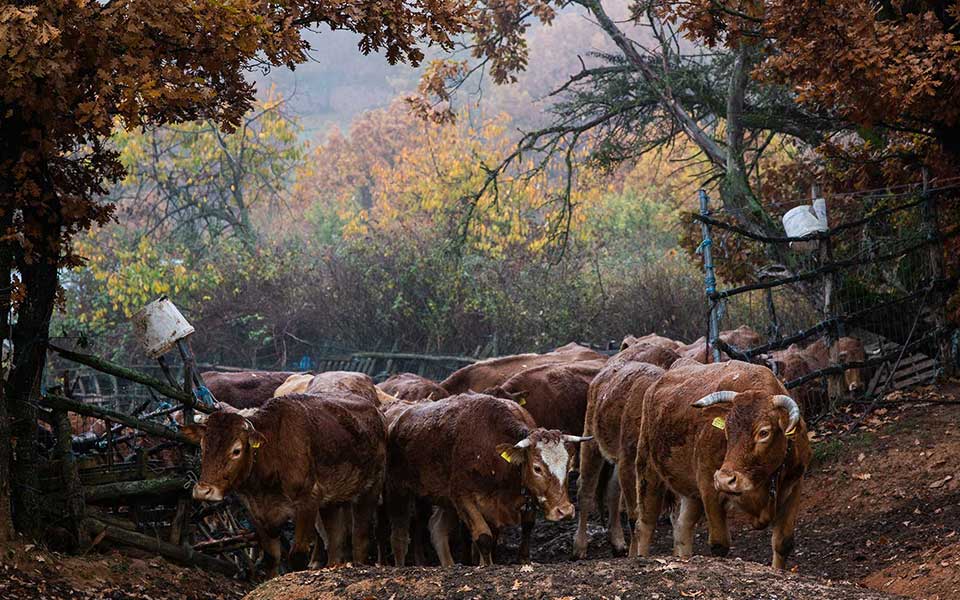
© Stelios Papardelas
Despite these difficulties, seeking beans from the farmer directly remains the best way to guarantee quality and fair trade – an investment in both the taste on your plate and the livelihood of the producer.
Beyond the village, on the mist-covered hills surrounding the abandoned brick-built houses of Gavros, livestock farmer Anna Moschou tends to her 70 free-grazing cows, which belong to the indigenous Hellenic Red breed of Kastoria-Krystallopigi. This resilient breed, numbering around 6,000 head, grazes exclusively in the mountainous pastures of Kastoria, Florina, and Kozani, at altitudes ranging from 1,100 to 1,800 meters. The pristine mountain environment offers them an abundance of wild herbs and fresh, clean water from alpine springs.
The Hellenic Red breed is perfectly adapted to the region’s rugged terrain and harsh climate, producing exceptionally tender and flavorful meat. Local chefs and restaurateurs proudly feature it on their menus, considering it a hallmark of quality and authenticity.
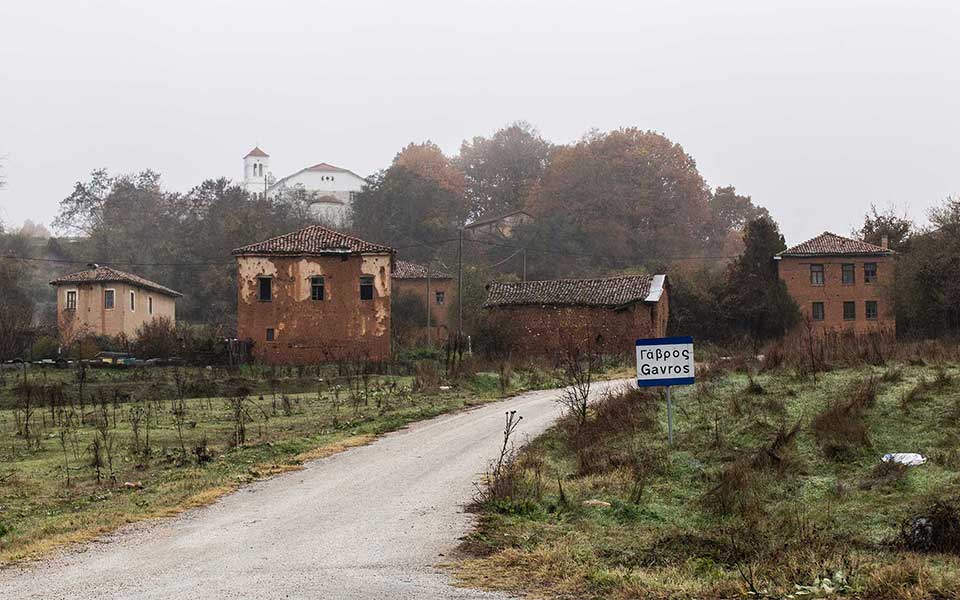
© Stelios Papardelas
Anna is a member of a cooperative of 80 livestock farmers established in 2017 through the Agricultural Cooperative of Cereals and Livestock Products of Kastoria, under the technical guidance of Andreas Foskolos, a professor of Animal Science at the University of Thessaly. As I follow Anna and animal technician Rozalia Stefopoulou through the damp grass, they share insights about the breed’s history. “It was developed about 30 years ago by crossbreeding local cows with Limousin bulls and was officially certified in 2011. All our cattle are registered with the Thessaloniki Animal Genetic Resources Center,” Rozalia explains.
Anna passionately adds, “Our quality control program, in collaboration with the Aristotle University of Thessaloniki, has shown excellent results. Our cattle graze outdoors for over eight months a year, and any additional feed is grown by us and our neighbors in the highlands. The results speak for themselves.”
Despite their dedication, market distribution beyond the three regional units remains limited. “Most of us don’t fatten the calves ourselves; we send them to specialized feedlots after weaning, as the costs of fattening are too high for us,” Anna admits.
This year, she has taken her first steps into fattening a small number of female calves, noting that their meat, though yielding less quantity, is tastier and naturally marbled with just the right amount of intramuscular fat – an aspect many consumers may not yet appreciate.
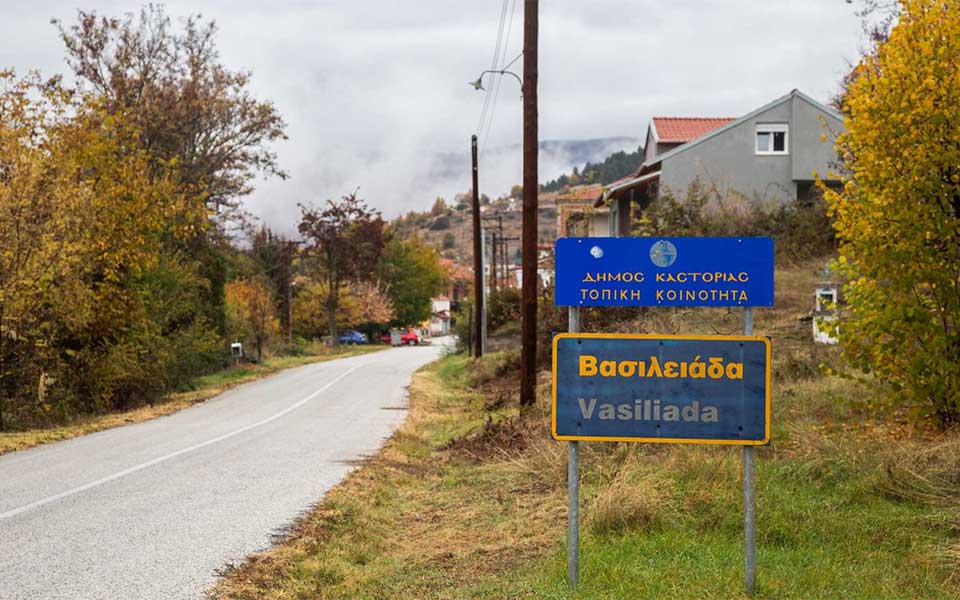
© Stelios Papardelas
Stop 3: Vassiliada & Mavrochori
After a long, cold, and rainy day of endless walking, I find comfort by the stone fireplace in Sevi Liouza’s family home in the mountainous village of Vassiliada. I hold a glass of cool, crystal-clear, fragrant apple juice in my hands – pure as spring water. The juice, crafted from Sevi’s organic Fuji apples, comes from trees planted on the slopes of Mount Vitsi, on the very estate where she was born 40 years ago. In 2013, she took over the family farm and breathed new life into it.
Together with her partner Giannis – both forestry and environmental science graduates – they cultivate a variety of apples, including Red Delicious, Fuji, Golden, Granny Smith, and Gala, alongside other fruits such as persimmons, chestnuts, quinces, and pears. Sevi carefully stores her produce in her own refrigerated units in the basement and distributes them directly to select stores, such as the cooperative grocery Katalachou, Bios Coop, and Koukouli, as well as to individual customers.

© Stelios Papardelas
Since 2017, Sevi has expanded her operations with an official cottage industry license, processing part of her harvest into dried apple slices and her signature apple juice. “We’re also experimenting with products from other fruits, like pear juice and molasses,” she tells me. But despite their best efforts, nature often has the final say. The past two years have seen extreme shortages in production, but she remains hopeful that this season will be better. “You do everything you can to protect your crops – like using anti-hail nets – but there are always unpredictable factors. Organic farming is about prevention, nurturing the health of plants and soil, and keeping diseases at bay, as much as possible.”
In the nearby lakeside village of Mavrochori, another apple grower, Anna Atsou, took a leap of faith, leaving behind a successful career in a prominent advertising agency to embrace an entirely new way of life. Applying her marketing skills and building on newfound knowledge through specialized training and seminars, she and her husband started by working on scattered family plots. Eventually, they consolidated the land into a single 20-stremma (20,000 sq. meters) orchard.
“I was shocked to see how many apples were wasted simply because of a tiny bird peck or a minor blemish,” Anna recalls. “Consumers only want perfect-looking apples, and the rest were discarded.” Determined to change that, she set up a small processing workshop in 2021 in her husband’s old family home and is already planning an expansion.
From this charming workshop, Anna’s products take shape under the brand I Want an Apple Now!, a name inspired by her young daughter. Her product line includes apple juice from Fuji and Gala apples, apple chutney, pulp, and a ready-to-use apple pie mix made without sugar or preservatives. These products have found their way to bakeries, delis, and cafés across Kastoria. In Athens, they can be found in select stores such as Frouteries Katselis (alongside her fresh apples), Thanopoulos Supermarket, Kyra-Despina Grocery in Faliro, and Stergiou Bakery in Voula.
“The weather presents challenges,” Anna admits. “This year wasn’t particularly great for some varieties, but we’re doing what we love and have big plans for the future.”
This article was previously published in Greek at gastronomos.gr.












